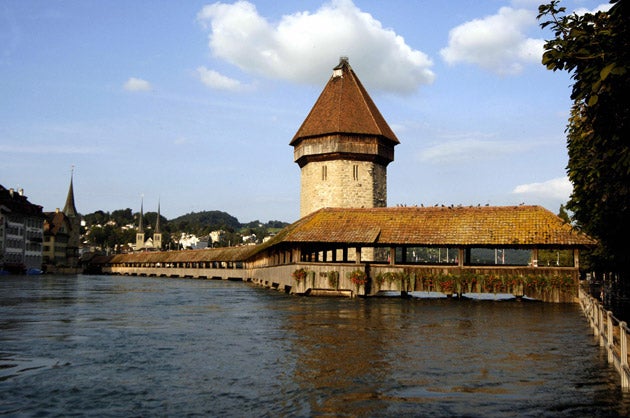You'd expect Luzern, being right in the heart of Switzerland, somehow to encapsulate the Swiss essence. And this little city does not disappoint. It is exceptionally neat and clean; even the cobbles of the old town look polished. The transport is well organised. There are a host of conventional tourist attractions including the medieval half-timbered and painted houses, art museums and upmarket shops, as well as excursions into the lakes and mountains that surround the city. But Luzern is not just a pretty face: there's also an eccentricity and creativity which seems, at first sight, out of keeping with the comfortable demeanour. And it can be easily enjoyed on a short stroll through the city centre.
Start on the south bank of the river Reuss, in the modern quarter of the city, and walk over the unique Chapel Bridge, but do take your time over it. Apart from its bizarre dog-legged shape, the inside of this covered bridge which dates from the 14th century is decorated with paintings depicting scenes of the city's history. Beside the bridge is a 700-year-old watertower, reputed to be Switzerland's most-photographed monument, whose phallic form is also available as a chocolate souvenir in Luzern's many chocolate shops.
Once across the river, follow the lakeshore and turn left up towards the Löwenplatz. This is where the fun starts. On your right is a round building that houses the Bourbaki Panorama, a 19th-century circular painting that conveys a stirring anti-war message and whose arresting visual fashion seems to presage the cinema.
A short way further north, up Denkmalstrasse, you'll find the equally impressive Alpineum, which shows the beginnings of mountain tourism in Switzerland through the most convincing three-dimensional photography, created in the early 1900s.
On the opposite side of the road is a sculpture which was dubbed "the saddest and most moving piece of rock in the world" by the American writer and traveller, Mark Twain. The Dying Lion of Luzern was hewn out of the natural rock to commemorate the death of Swiss mercenaries during the French Revolution. Twain certainly had a point – you need a heart of stone not to be affected by the poor beast.
A short stroll from this monument is another surprise: the Glacier Garden. Its centrepiece is a striking rockscape of potholes, grooves and strange ripple effects. It looks like a modern sculpture yet dates from the time, 20 million years ago, when Switzerland was covered by glaciers. The garden also boasts a little museum with relief models of the Alps, a pond with interesting varieties of trout and a wooden tower with great views over Luzern towards the real Alps.
The star of the show, though, is the Hall of Mirrors, a 19th-century labyrinth, modelled on the famous Spanish Alhambra. It creates a fascinating and disorienting illusion, filled with ornate columns, fountains and palm trees. I was spared an embarrassing collision with a pane of mirrored glass which I mistook for a palm-fringed avenue, by a group of schoolboys who politely warned me instead of waiting for the crash and having a good laugh. This is Switzerland, after all.
A 20-minute stroll from the old town along the lakeside promenade, past grand hotels and tea-rooms, is the Transport Museum – remarkably, given the surfeit of fine art elsewhere in Switzerland, the country's most-visited museum. This year marks its 50th anniversary, which has been celebrated with the construction of a new hall devoted to road transport through the ages. But this is only one aspect of the vast hands-on museum, whose 3,000 exhibits range across all forms of transport, past, present and future and include aircraft flight simulators, a planetarium and dozens of impressive locomotives.
Even the entrance hall is striking: the exterior wall is decorated with thousands of wheels, rims, propellers and steering wheels and once you're inside there is enough to keep a family occupied for day.
An appropriate way to get back to central Luzern is on the city's characteristic, and most enjoyable form of transport, a boat. From a pier near the museum, ferries criss-cross the lake, taking you to Luzern railway station in one direction or, if you have the time to explore the expanses of Vierwaldstättersee, off to pretty lakeside villages such as Weggis where a funicular railway will trundle you up the implausibly green hillside to enjoy a wonderful Alpine panorama from the top of Mount Rigi.
Getting there
Luzern is easily reached via Zurich airport, from where trains depart hourly and take about an hour. A single ticket costs Sfr27 (£15.20). Direct fast trains also link Luzern to Basel and Geneva, with good rail connections from London via Paris.
Seeing there
Bourbaki Panorama, Löwenplatz 11 (00 41 41 412 30 30; bourbakipanorama.ch). Open 9am-6pm daily (except Monday, 1-6pm), admission Sfr8 (£4.50).
Alpineum, Denkmalstrasse 11 (00 41 41 410 62 66; alpineum.ch). Open 9am-12.30pm and 1.30-6pm daily between April and October, admission Sfr5 (£2.80).
Glacier Garden, Denkmalstrasse 4 (00 41 41 410 43 40; gletschergarten.ch). Open 9am-6pm from April to October, 10am-5pm in winter, Sfr12 (£6.80).
Transport Museum, Lidostrasse 5 (00 41 41 370 44 44; verkehrshaus.ch). Open 10am-6pm daily (winter to 5pm), admission Sfr24 (£13.50).
More information
The main tourist office is by the west exit of the railway station at Zentralstrasse 5 (00 41 41 227 17 17; luzern.org). It opens 8.30am-6pm Monday to Friday, 9am-7.30pm at weekends (9am-1pm in winter).
Hannah Russell
Subscribe to Independent Premium to bookmark this article
Want to bookmark your favourite articles and stories to read or reference later? Start your Independent Premium subscription today.


Join our commenting forum
Join thought-provoking conversations, follow other Independent readers and see their replies